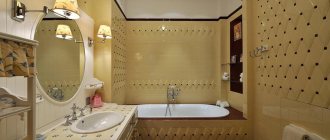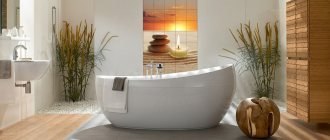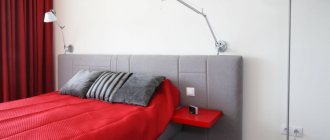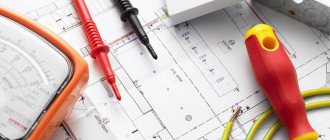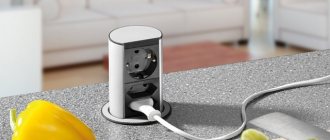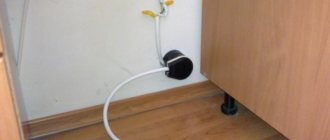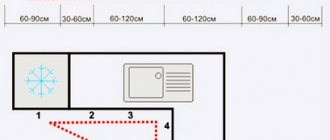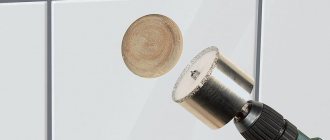In modern interiors, the rule of minimalism is usually applied. The fewer objects are visible in a room, the more spacious and comfortable it seems. This also applies to the choice of location of electrical outlets. When planning a renovation, it is advisable to determine in advance at what height the sockets for the TV will be, since such household appliances are almost always in the house and often in more than one copy. The correctly selected location of the outlet unit does not spoil the interior and facilitates the operation of the TV and connected additional devices.
Pros and cons
TV is a popular electrical appliance. Modern technology is equipped with many tools, functions and advanced capabilities. Flat TV equipment is mounted on the wall, since this arrangement saves space and looks modern. In order for the equipment to work, you need a connection to the network, which is why it is so important to know how to correctly and correctly arrange sockets for the TV.
Proper installation of equipment has a number of advantages:
If the connector is mounted far from the TV mount, then it will need to be moved, and this is a considerable amount of work. You can use an extension cord, but it will unsightly pass through the room, spoiling the appearance of the room.
Location of lighting points
Lighting control points in the house are divided into three main groups:
- This includes classic switches - these are devices of different types, often with one or two keys. But thanks to three-key switches, you can simultaneously use three different groups of lighting installations.
- This group includes switches, which, when activated, control several lighting sources from different places at once.
- This group includes devices in which lighting control mechanisms are already built into the lighting tools. These include a table lamp and a floor lamp/
In the apartment, almost all rooms are equipped with one- or two-key switches, which is considered justified and, most importantly, comfortable.
The category of general lighting often includes lamps placed under the ceiling, providing uniform diffused light
For example, for a bathroom, an additional light source can be a lamp above the mirror. But regulation for such a device is carried out using a built-in switch
The bedroom has its own unique switch system. It allows you to adjust the light source simultaneously from different places. Let's look at convenience using an example.
Each sleeping place must be equipped with a lamp in the form of a night light on a table, bedside table, wall sconce or floor lampEvery time you need to turn the light on or off, you have to get out of bed, since the switches are located quite far from the bed. The solution is obvious. Three switches are installed in the room at once. One is at the exit from the room, and the other two are on both sides of the bed. As a result, it has become very easy to regulate the lighting in the bedroom, and access to switches will be at hand.
How to choose the right place
It is better to position electrical sources so as not to interfere with the operation of the TV. You should know how to install them in different rooms.
In the living room
You need to choose a place to install a television outlet depending on the height of the receiver. The formula for calculating distance looks like this:
Connector height = distance from the floor to the TV + equipment height divided by 2. This calculation is suitable for a TV with a regular antenna when there is no satellite. The connectors are located behind the device. For modern models, you need to additionally install a second socket for the set-top box.
It is recommended to equip a multimedia socket with an HDMI interface behind the receiver, the cable from which will lead to the place where the additional equipment is located.
It is required to press the receiver as tightly as possible against the wall. It should look like a painting and fit seamlessly into the design of the room. If the socket is placed incorrectly, it will be difficult to install the bracket.
In the bedroom
To determine the location of the height of TV sockets in the bedroom, you need to lie down on the bed, relax, close your eyes, then open them and look at the intended location for mounting the TV.
The area where the eye first fell will become the center of the monitor where the bracket is installed. Points to pay attention to when placing the panel:
It is recommended that during viewing the angle of deviation from the middle of the display should not be more than 30°.
When placing the receiver in the bedroom, choose a distance of 1.5 meters from the floor, and install a block of sockets at a height of 25 cm from it.
In the kitchen
Housewives like to watch movies and TV shows while in the kitchen.
More often when preparing dishes, so the standard placement of equipment according to the principle “middle of the screen - at eye level” is unacceptable here. If the TV is equipped with an LCD screen, then in the horizontal plane it has a large tilt angle with a small change in contrast. A vertical plane with a slight tilt darkens the monitor.
If the owners will watch TV while standing, then it should be hung at a distance of 1.75 cm from the floor. If sitting on a chair, then lower.
Installation
To connect a television outlet (simple), you need to run a television cable into the wall in advance, disguise it with plaster or lay it in a cable channel. The second option will require overhead TV sockets.
Basic installation rules:
- Before starting installation work, you need to make a corresponding hole with a drill and install a plastic box, called a socket box, into the wall.
- Extend the cable to a length of 15 cm.
- The television socket is disassembled into its component parts.
- Connect the TV cable in the direction of the arrow and secure it with a clamp.
- After this, you need to securely fasten the screw.
- Using a tester, you need to exclude the possibility of a short circuit due to incorrect connections.
- The parts of the television socket are installed in place.
After assembly, unprotected connectors must be closed, the wires hidden behind the housing. The insulation of the wires must not be damaged.
The installation of a pass-through television socket differs from the previous version. If a person has not limited himself to installing only one outlet for the TV and wants to use a star circuit, he needs to know how to install it correctly:
- First, install the splitter, and only then install the sockets.
- For each output on the splitter, one television cable is attached to a socket, which ends with the installation of a simple or terminal socket for the TV cable.
- When installing simple modules, you need to take into account that they do not have filters.
It is necessary to pay attention to cleanliness. The possible value falls within the range from 40 to 1000 MHz, but some devices narrow these boundaries
If you do not want to install digital television, or when using a sequential circuit, you need to take care of the quantitative limitation. The more “points” are installed in the house, the worse the signal will pass through them.
Installing a television outlet is a responsible undertaking. In order to install them throughout the house with your own hands, you should have at least basic knowledge of electrics, or understand this issue professionally.
If you have designed a complex circuit, then it is better to contact your provider for all installation questions, since a specialist can advise on the nuances of connection.
Sequence of DIY work
Let's look at how to install a TV outlet yourself.
When is gating necessary?
Grooves are used on monolithic and brick walls with large surfaces. This is true for external load-bearing coverings and partitions without the presence of power cords in them. The thickness of the drilling is large, such walls cannot be damaged. To groove internal planes, you will need permission from the construction department.
Installation options without grooves
This open installation involves installing sockets on an external wall without drilling channels and holes for socket boxes.
The wires will run outside along the plane. Also, the optimal solution is to install surface-mounted electrical installations. This option is great when the renovation has already been done and you don’t want to spoil the finish. The connector can even be installed on top of tiles.
Selecting wire cross-section
The indicator is measured in square millimeters and shows throughput. To ensure safe operation of the receiver, purchase a cable with a reserve cross-section, then the insulation will not be damaged by the load.
The wiring cable is always rounded up. For example: when calculating it turned out to be 2.2 square meters. mm. This means that you need to take a 2.5 square cable.
Fastening and fixing
There are 2 options for connecting the connector.
The star pattern means that the old wiring is removed and the new wiring is placed through the splitter. It is designed to branch a signal, divide it into packets and amplify it. Electrical sources are placed at the entrance of the wire into the living space from the entrance. Then the antenna conductors are wired. Used frequently. Advantages:
The second installation method is daisy chain. The main cable extends to any TV, and then branches into 2 or more parts to other devices directly at the connector. With this connection scheme, there is a saving on cables. The disadvantage is that the quality on the first TV will be higher than on subsequent ones.
How much wire is needed
Now there are different methods of data transmission that require their own connection to the network. Instead of 1 socket, install a block that contains at least 4 connectors.
Antenna cable difference
For a high-quality connection, in addition to correctly selected sockets, you will need an antenna coaxial cable, which has a special structure. Unlike 2- or 3-core electrical wire, it has one core to carry the TV signal and a protective shield that acts as a barrier to surrounding electromagnetic fields.
Externally, a television cable is a thick elastic round wire, usually with black or white PVC insulation. For in-wall installation, the color of the external insulation does not matter.
Structure of a coaxial antenna cable: copper conductor for transmitting a TV signal, dielectric insulation, braided protective metal screen, outer plastic sheath
A thin insulating layer adjacent to the central core breaks the galvanic connection with the shielding braid. The screen, in turn, protects against electromagnetic interference and prevents the emission of sensitive high-frequency signals, while also serving as an additional conductor. If any of the components fail, video transmission will be disrupted.
Here are several types of cables that are suitable for laying under plaster or other finishing material:
- SAT 50 (SAT 703);
- RG-6 (and for external use);
- RG-11 (F1160BVM COMMSCOPE).
When purchasing, be sure to check the strength of the sheath, and during packaging and transportation, try not to bend the cable so as not to damage the integrity of the copper core and screen braid.
Adviсe
When using tools, handles must be insulated. Sockets are installed only in a de-energized room. It is important not to contact your body with exposed wires. Before connection, each wiring is checked with a phase indicator.
To install an outlet under the TV yourself, you need to have knowledge and follow safety precautions when working. The placement of the TV on the wall is very convenient and modern. Depending on the place where it will be viewed, the height of the sockets is set at an optimal distance of 120-140 cm from the floor.
Myths about installation requirements
The established requirements are basic when installing sockets and switches in residential and other premises. In this case, you can use a free arrangement method, that is, fix the elements in an order that is comfortable for the user. This option is often considered the only one, but we must not forget about the standards that ensure safety.
Video: DIY installation of switches indoors
All elements of the electrical circuit are important and require safety during installation and operation. Compliance with requirements and standards is a decision necessary to achieve high quality work.
TV socket height on the wall
The choice of installation height for TV outlets is directly related to the location of the TV on the wall, since it must hide the outlet block.
The correctly selected height of TV sockets on the wall allows you to:
1. Completely hide wires, cables, connectors, connections, etc. I think many people are familiar with the irritation of randomly hanging, tangled wires in the TV area.
2. Press the TV against the wall as much as possible. Ideally, TV looks like a painting in an apartment and fits seamlessly into any interior. It’s no wonder that manufacturers are striving to make TVs thinner and more elegant.
3. Avoid problems when installing TV mounting brackets. There are often cases when the incorrectly selected location of sockets behind the TV interferes with installation of the device in the required location, or during installation the power lines, antenna cable, etc. are damaged.
4. It is easy to connect any communications to the TV (Antenna cables, Twisted pair, HDMI, etc.)
In order for you to get all the advantages described above, you must already at the design stage have a detailed design of your room, choose, or better yet immediately buy, future furniture, the TV itself and the mount for it. Knowing all the features of the equipment, you can accurately calculate where it is most convenient to place sockets behind the TV, taking into account all the features.
The standard installation height of sockets in an apartment, which we described in detail, is not suitable for a wall-mounted TV; a different approach is needed here.
If you look at the back of the TV, you will see that it is uneven, there are various indentations there, especially in the locations of the connectors, and this is where you need to draw conclusions. In addition, you also need to consider the type of bracket you have for mounting the TV to the wall. By comparing these and some other indicators, you can quite accurately calculate the ideal location of sockets for your TV.
But most often it happens that the TV has not yet been selected at the stage of installing the electrical wiring, or you change it quite often and do not want to redo the location of the sockets every time for a new model; in addition, the equipment is quite capricious and can fail, the new TV is unlikely to be accurate the same configuration. For such cases, a universal method for choosing the installation height of sockets behind the TV was developed, which teaches that:
The optimal height for installing a TV socket on the wall is 130 – 140 cm (The size is indicated to the center of the socket from the floor)
This height of installation of the socket block is usually chosen for TVs installed in the hall or living room, in places where we most often watch TV shows while sitting on the sofa, armchair or chair.
I will now tell you why exactly this height and how it was calculated; moreover, I will present a formula using which you can independently determine the installation height of TV outlets, no matter where it is located, in the kitchen, bedroom or bathroom.
By the way, be sure to read at what height the TV should be installed in the bedroom in order to correctly install sockets under it.
Coswall CS-OFSO-3DE-SW – triple socket
Another universal model that works with a rated mains voltage of 100-240 V. The product has a rectangular shape and is equipped with 3 sockets. The socket is ideal for installation in an office or next to a desktop computer.
The design has rather large dimensions - 222x118x65 mm. And the thickness of the front model is only 2.5 mm, so the structure will not stick out from the wall. In reviews, users praise the good opening mechanism. If in most similar sockets the socket “flies out” instantly after pressing the button, then in the case of CS-OFSO-3DE-SW it slides out smoothly, which means it will last longer without breaking.
Pros:
- 3 connectors;
- silver cover;
- smooth opening;
- metal case;
Minuses:
- no USB port provided;
- weight.
VIEW ON ALIEXPRESS
FORMULA FOR CALCULATING THE HEIGHT OF INSTALLATION OF OUTLETS FOR TV
So, the key indicator for calculating the location of sockets is the installation height of the TV. It is customary to place the TV opposite those watching so that its center is either at eye level or slightly higher.
In the hall or living room, TV is most often watched while sitting on the sofa or in an armchair. For the average person, about 175cm tall, it is most convenient to place the TV at a height
120cm from the floor to the center of the screen.
Sockets are made behind the TV, along its vertical axis, closer to its top edge, as shown in the image below. The result was exactly this installation height, using simple calculations:
The height of modern TVs with a diagonal of 32” was taken (the most common minimum diagonal of purchased TVs), which is on average 48 cm; less is rarely purchased for installation in a hall or living room, often more. In addition, the height of the modern socket complete with frame was taken into account
8 cm. Next, calculations were made using the following formula:
Formula for calculating the installation height of sockets behind the TV
For a TV installed 120cm from the floor, the calculation is as follows: 120+48/2 – 8 = 136cm. For clarity, in the diagram above all sizes are presented in rounded form.
If you strictly follow the formula, the top edge of the socket will be lower than the top edge of a 32″ by 4 cm diagonal TV, so even watching TV while standing, you still won’t see the wires and plugs.
Using this simple formula, you can quite accurately calculate the installation height of almost any socket for any TV in the apartment, and if you do not accurately determine the diagonal size and installation height of the TV, make them 140 cm from the floor.
If conditions allow - the thickness and material of the wall, try to recess the socket block deep into the wall, for example as shown in the image below, this will be the best option for installation.
In addition to the installation height, you need to know what and how many outlets there should be for a TV in modern conditions, you can read about that HERE.
If you have any additions, corrections, comments or just questions, be sure to write in the comments to the article, I will answer everyone!
Source
Creative approach to problem solving
Well, for dessert, we offer you several options that can not only be effective, but will also allow you to additionally decorate the room.
Decoration
A very interesting way out of the situation would be not to hide the wires from the TV on the wall, but to decorate them, that is, to make them part of the interior.
Here are some interesting examples:
There are a lot of decoration options, and even manufacturers offer their own solutions. And if you have enough experience and imagination to create and implement your ideas, you can create a real masterpiece for mere pennies.
The simplest methods of artistic decoration will be the following options:
- Parts of the wires can be placed behind the furniture, attached to it on the reverse side with tape or staples;
- Install live plants under the TV;
- Use varnished driftwood;
- Make a necklace out of wire by putting large beads on it;
- Use ready-made plastic fasteners from the manufacturer;
- And much more.
Decorative boxes
If the wires themselves do not bother you much, but massive tees and extension cords are an eyesore, then an original solution to the problem would be to place them inside a decorative box, which you can make yourself, or purchase a ready-made version. By the way, instructions for assembling one of these solutions will be given in the video attached to the article.
Various devices are also very effective, allowing you to hide and secure the largest parts in inconspicuous places.
Here are some photos with similar solutions:
That’s basically all we wanted to tell you about how you can hide or disguise the antenna wire for a TV and other cables. No need to put up with reality! Approach the matter wisely, and the result will not keep you waiting!
How to properly design sockets for a TV on the wall
Modern TV is a real multimedia station. Game consoles, audio equipment, Internet cables and many other peripherals are connected to the TV. When hanging a TV on the wall, it is very important to correctly design the supply of electrical power and low-current networks: communications must be hidden and at the same time meet safety standards. General rules for the location of TV outlets, as well as specific recommendations for each room in the apartment, are given in the article below.
Choice
In order for the built-in unit to be better combined with the countertop and at the same time be as functional as possible, several key conditions must be taken into account.
- The total power of all electrical appliances that are supposed to be used. This is necessary so as not to cause overvoltage in the apartment (house).
- The one-time load that a particular block can withstand. This information must be included in the instructions for the device.
- Number and type of connectors required. This indicator depends on whether the kitchen should have a TV, the Internet, or only household appliances.
- Availability of additional functions. For example, pushing out the plug when turning off the device. This is not only very convenient in itself, but also helps you avoid leaving appliances on.
- The color and pattern of the lid of the built-in unit, which should either match the countertop or go well with the details of the kitchen unit. For example, with handles.
- Manufacturing company. The functionality, style, durability and safety of the device depend on this item.
It is best to buy devices from companies whose brand has long been known. In this case, you can be sure of the high quality of the devices, since well-known companies value their reputation. In addition, this option allows you to obtain a guarantee from the manufacturer, so that if a defect is detected, you can exchange or return the product without much difficulty.
You also need to pay special attention to the block markings. It can be used to determine the authenticity of the brand.
Large companies make it using stamping, and not with ink stamps or in the form of a sticker.
It is worth checking the equipment of the device. All connections and fastenings must be included in the kit. Otherwise, you must immediately notify the seller of the shortage. After all, after purchase it will be difficult to prove the absence of components.
And finally, the main thing is to check the functionality of the outlet. The seller is obliged to demonstrate the serviceability of the unit by connecting it to the electrical connector.
Universal formula for calculating the height of sockets
The height of TV outlets does not always correspond to the standard rules for conventional 220 V electrical networks. In this case, the basis of the calculation is at what height
TV receiver is located. For ease of viewing, the TV is placed or hung so that the center of the picture is opposite the viewer’s eyes or slightly higher.
The height at which the sockets can be optimally positioned behind the TV on the wall is calculated using the following formula:
Position H H from the center of the screen + H TV/2 - H frame, where H is the height.
The height of modern TVs is about 48 cm (with the most common diagonal being 32 inches). Rosette frame - 8 cm. Human height is 175-180 cm, the average distance from the center of the screen to the floor is 120-125 cm. Thus: 120 + 48\2 - 8 = 136 cm. Sockets are most often placed above the center of the TV.
Air conditioner
A microclimate control system, as a rule, should be connected directly from a separately laid cable, which in turn is connected from a separate circuit breaker in the electrical panel. If this condition is met, then the air conditioner is connected directly without installing an outlet. In such cases, sockets are not installed.
However, not all air conditioners operate directly, so you will have to install the outlet in close proximity to the device. Considering the location of the device, which is usually under the ceiling, the socket must be installed thirty centimeters from the top, so that the air conditioner wire reaches the socket and is not strained.
Socket placement errors
Before you begin installing sockets in the kitchen, you should mark the points at which power points will be installed; the selection of the location should be carried out in accordance with safety conditions.
1. Installation of wiring in the kitchen is carried out without a plan for the placement of kitchen furniture.
Before installing electrical wiring, be sure to draw up a plan for the location of all furniture and kitchen appliances.
2. Free access to connection
The main requirement for placing sockets in the kitchen is that they must have easy access, and if necessary, it is possible to easily turn off household appliances.
It is not advisable to install sockets in places that are below the work surface or countertop. Installed power points below the required level require cutting of surfaces for easy access. Of course, such changes to the headset are not entirely acceptable, so before installing, you need to think through everything in detail.
Sockets installed above the work surface can make their own adjustments to the overall appearance of the kitchen. A well-thought-out plan will allow you to choose the optimal installation solution.
You should not install sockets behind cabinet furniture and built-in appliances, as this will add more work to the technician. To put it simply, placing sockets in the kitchen for built-in appliances can lead to unpleasant situations that are best avoided. In such situations, you will have to cut a hole in the back wall.
It is prohibited to install an outlet behind the structure itself without access to it, because if necessary, it will be impossible to reach and turn off the electrical device. As an option, you can install a socket at the level of furniture legs, but provided that the distance to the floor is at least 20 centimeters. It is better to install sockets in a kitchen with built-in appliances and furniture on the side, where there is easy access.
3. Connecting sockets for “wet equipment” without using an RCD.
If “wet appliances” such as a dishwasher, water heaters, or washing machine are used in the kitchen, their outlet lines must be connected through an RCD.
It is also forbidden to make an outlet in the immediate vicinity of the sink, since water and electricity should be far from each other, only in this case maximum electrical safety is achieved.
4. Connecting a hob or electric stove
It is strictly forbidden to install an outlet opposite the hob or stove. As a result of cooking, warm air will constantly heat the cable, which over time will cause the insulation to dry out and it will crumble. Also, the heat may melt the body of the outlet, which can negatively affect the appearance and performance of the power point.
5. Installation of sockets near gas pipes and communications.
| According to the rules of the PUE, it is prohibited to install sockets in close proximity to gas pipes and communications (water pipes, sinks, radiators). The minimum distance to the sockets in this case should be at least 50 cm. |
At what height should TV sockets be placed in different rooms?
If the TV model is not yet known, then the height of the sockets from the floor is assumed to be 140 cm.
The minimum kit usually consists of:
The calculation of the location and composition of the outlet assembly may differ for different rooms of the house.
In the bedroom
You can find out where to put the TV in the bedroom experimentally: lie down, close your eyes, open them and look at the chosen place. They try to place the center of the screen where it is most comfortable to look. It usually turns out that viewing programs and operating equipment is more convenient at a height of 1.5-1.6 m.
For subsequent fine-tuning of the TV position, adjustable bracket designs are used.
To ensure that the TV fits well into the interior, different techniques are used:
Depending on the decor, you can disguise socket nodes and wires in different ways.
In the kitchen
To properly make socket units in a small kitchen, the location of the TV is chosen taking into account the following nuances.
In the living room
The location of TV outlets in the living room often differs from other rooms in the socket layout. Many users prefer to create multimedia complexes in such rooms - home theaters and music centers.
To connect all involved devices, the number of elements increases. Sockets may be needed for:
To hide wires and sockets, and at the same time save money, it is convenient to make a cable outlet. The industry produces such products of various designs and structures that allow you to neatly and discreetly place communications behind the TV receiver and other devices.
Rules for selecting power supply devices
First of all, you need to figure out what and where the furniture will be located, as well as electrical household appliances in the room; for clarity, it is optimal to draw a plan diagram in the correct proportions, on which to indicate all the pieces of furniture and electrical equipment that need to be connected to the electrical network.
Then indicate all the sockets (electrical, television, telephone and computer), it is advisable to make a small reserve. It is preferable to install sockets for devices that do not change their location (TV, system unit, etc.) so that they have constant access, but at the same time, it is better if they are hidden behind this equipment.
Sockets for non-permanent use, installed in open areas of wall structures, should be optimally placed at the same height - thirty centimeters from the floor surface; their number must be selected taking into account that a household vacuum cleaner can reach any room.
Sockets located above a computer desk, chest of drawers, bedside table, etc. are optimally installed at a height of 10-18 cm from the furniture surface. In order to correctly select the installation height of the switch, you first need to determine in which direction the door leaf will open in this room and install the switch on the edge of the door frame where the handle is located. At a height from the floor of approximately 75-95 cm, depending on your height, that is, this distance is determined in practice.
The position of the switches is strongly tied to the type of room, for example, in a narrow corridor or on a flight of stairs, they are usually installed at the start and finish, in the bedroom or living room; it is optimal to install switches near the entrance to the room, as well as at the bedroom places to control lighting while lying down.
Select the height of the switches according to the same rules, taking into account from what position they will be used more often, in other words, if it is at the exit from the room, then we take a height of 75-95 cm, taking into account your height, and if near the bed, then a switch is needed Place it at such a height that it can be easily reached with an outstretched arm.
In those areas where you do not yet know how furniture or electrical devices will be arranged, we recommend installing sockets at a height of thirty centimeters, and switches ninety centimeters from the floor surface; most often this is the most optimal height for switches and sockets.
By putting into practice these simple recommendations, common sense and not forgetting about basic safety, you can find the best location and height of sockets and switches in your apartment. Don’t forget a simple rule: it’s better to calculate and determine everything well in advance than to redo everything all over again later.
Which sockets to choose for your TV
TV sockets are divided by purpose: power, Internet, multimedia, etc.
In addition, they differ in design:
Sockets are also selected according to the installation method - for hidden installation or external. In the latter option, the wires are usually laid in cable ducts.
Combination type sockets are available for sale:
A mixer block is often installed with such outlet units. It combines signals from different cables.
Advice! For a more compact placement, you can install sockets with 3 outputs and 2 inputs.
Terrestrial and satellite TV are connected via separate cables. You can connect the sockets to each other using a cable - in a pass-through circuit, in a star circuit, or use single nodes. Sockets can be selected according to color, material and design along with power connectors.
Source
Balcony, loggia, terrace
When planning electrical installations in an apartment or house, we must not forget about lighting on the balcony or terrace. Plan two sources of light - the main one and an accent in the form of wall lamps. Homeowners should provide sufficient lighting in the entrance of the house, as well as lighting for the door of the house and garage.
Installing lighting points on loggias and terraces is simply necessary. In this case, it is quite possible to install the switch indoors in front of the exit to the loggia or terrace.
Switches for outdoor lighting can be located in front of the home's front door or on the deck. At least one electrical connector with a waterproof cover must be installed on the front of the house.
When planning electrics in a house or apartment, first of all, we must be guided by functionality. Lighting fixtures, electrical sockets, and switches must be placed thoughtfully and in the right quantities. Only this approach will allow you to live comfortably, without thinking about the little things.
TV socket height on the wall
The choice of installation height for TV outlets is directly related to the location of the TV on the wall, since it must hide the outlet block.
The correctly selected height of TV sockets on the wall allows you to:
1. Completely hide wires, cables, connectors, connections, etc. I think many people are familiar with the irritation of randomly hanging, tangled wires in the TV area.
2. Press the TV against the wall as much as possible. Ideally, TV looks like a painting in an apartment and fits seamlessly into any interior. It’s no wonder that manufacturers are striving to make TVs thinner and more elegant.
3. Avoid problems when installing TV mounting brackets. There are often cases when the incorrectly selected location of sockets behind the TV interferes with installation of the device in the required location, or during installation the power lines, antenna cable, etc. are damaged.
4. It is easy to connect any communications to the TV (Antenna cables, Twisted pair, HDMI, etc.)
In order for you to get all the advantages described above, you must already at the design stage have a detailed design of your room, choose, or better yet immediately buy, future furniture, the TV itself and the mount for it. Knowing all the features of the equipment, you can accurately calculate where it is most convenient to place sockets behind the TV, taking into account all the features.
The standard installation height of sockets in an apartment, which we described in detail, is not suitable for a wall-mounted TV; a different approach is needed here.
If you look at the back of the TV, you will see that it is uneven, there are various indentations there, especially in the locations of the connectors, and this is where you need to draw conclusions. In addition, you also need to consider the type of bracket you have for mounting the TV to the wall. By comparing these and some other indicators, you can quite accurately calculate the ideal location of sockets for your TV.
But most often it happens that the TV has not yet been selected at the stage of installing the electrical wiring, or you change it quite often and do not want to redo the location of the sockets every time for a new model; in addition, the equipment is quite capricious and can fail, the new TV is unlikely to be accurate the same configuration. For such cases, a universal method for choosing the installation height of sockets behind the TV was developed, which teaches that:
This height of installation of the socket block is usually chosen for TVs installed in the hall or living room, in places where we most often watch TV shows while sitting on the sofa, armchair or chair.
I will now tell you why exactly this height and how it was calculated; moreover, I will present a formula using which you can independently determine the installation height of TV outlets, no matter where it is located, in the kitchen, bedroom or bathroom.
By the way, be sure to read at what height the TV should be installed in the bedroom in order to correctly install sockets under it.
Connection diagram options
There are two main connection schemes - parallel (“star”) and serial (“loop” or loop-through). All the rest, no matter how complex and intricate they are, are combinations of these two main options. They resemble standard electrical circuits, but are lower voltage.
#1: “Star” – several independent lines
Once upon a time we got by with one video receiver for the entire apartment, now there are televisions installed in almost every room. To connect all devices to a single cable leading from the panel or over-the-air antenna, a special signal distribution device is required - a splitter or splitter.
This is a kind of switching organizer that has one input for an antenna cable and several outputs for connecting TVs.
The origin of the “talking” associative name of the parallel connection option becomes clear: the splitter is, and all the cables extending from it are its “beams”
The advantages of parallel connection are not only good signal quality, which is usually weakened by pass-through sockets. During installation, the splitter is mounted in the most convenient place (for example, in the corridor), and it is easier to extend branches from it to other rooms. If one of the sprout cables becomes unusable, the functionality of the rest of the network will not be affected.
There is an improved star amplifier solution that ensures video signal attenuation is minimized. The standard power supply is designed for 2-3 receivers, but usually there are more, so the amplifier compensates for the lack and ultimately improves the video signal.
A standard amplifier (such as SAT Legrand) may be required in two cases: 1 – if there are a large number of working televisions in the apartment, 2 – if the signal from the over-the-air antenna or cable provider is very weak
For parallel connections, either terminal or simple sockets are required. It is better to prefer the end ones to avoid interference if one of the TVs is not actively used. They differ from simple ones by the presence of wave impedance (75 Ohms), which can balance the signal.
#2: “Loop” – pass-through sequential circuit
The pass-through scheme is considered cheaper, but of lower quality. It was actively used in previous years, but modern digital technologies have supplanted it, since they can only work via a parallel connection.
It turns out that you can use a “daisy chain” connection only in one case - if you have exclusively analog television and changes are not expected in the near future.
The sequential scheme requires the mandatory use of pass-through sockets located one after the other, but the last in the chain must be the terminal
Pass-through modules are equipped with filters that dampen the reflected TV signal. The absence of a filter can be easily determined by the characteristic ripples on the TV screen
When choosing products, pay attention to characteristics such as pass attenuation (from 1.5 to 5 dB) and branch attenuation (from 10 to 15 dB), give preference to devices with the lowest parameters
Please note that as the number of connections increases, the signal quality weakens, even if the network is provided with an amplifier or an auto-regulation system, so for 4-5 or more receivers it is better to use a parallel circuit.
And carefully read the agreement with the provider: in some cases they limit the number of active points, and impose a fine for installing additional ones.
FORMULA FOR CALCULATING THE HEIGHT OF INSTALLATION OF OUTLETS FOR TV
So, the key indicator for calculating the location of sockets is the installation height of the TV. It is customary to place the TV opposite those watching so that its center is either at eye level or slightly higher.
In the hall or living room, TV is most often watched while sitting on the sofa or in an armchair. For the average person, about 175cm tall, it is most convenient to place the TV at a height
120cm from the floor to the center of the screen.
Sockets are made behind the TV, along its vertical axis, closer to its top edge, as shown in the image below. The result was exactly this installation height, using simple calculations:
The height of modern TVs with a diagonal of 32” was taken (the most common minimum diagonal of purchased TVs), which is on average 48 cm; less is rarely purchased for installation in a hall or living room, often more. In addition, the height of the modern socket complete with frame was taken into account
8 cm. Next, calculations were made using the following formula:
Formula for calculating the installation height of sockets behind the TV
If you strictly follow the formula, the top edge of the socket will be lower than the top edge of a 32″ by 4 cm diagonal TV, so even watching TV while standing, you still won’t see the wires and plugs.
If conditions allow - the thickness and material of the wall, try to recess the socket block deep into the wall, for example as shown in the image below, this will be the best option for installation.
In addition to the installation height, you need to know what and how many outlets there should be for a TV in modern conditions, you can read about that HERE.
Source
Electrical markings
Any quality work begins with accurate markings. Most often, professionals use laser levels and axle builders for this.
With their help, you can quickly and accurately mark the centers for all the sockets in the room. It would seem that a couple of millimeters will not play a decisive role here. What's wrong with one block at the beginning of the room being slightly higher than the other at the end.
However, very often in apartments you come across wallpaper with horizontal or vertical stripes. And these stripes will clearly show when the socket box is not installed level.
The same can be said about the seams on the tiles.
Therefore, place all socket boxes in the room in the same plane. The recommended distances are as follows:
for sockets – 30cm from the floor
for light switches – 60-90cm
everything above the countertop, in the bathroom or kitchen – 110cm
After all the centers of the socket boxes have been marked, then proceed to marking the mounting points for the lamps, both on the walls and on the ceiling.
At the same time, you can mark out places for hanging plasterboard structures. Since in the future, when all the cables and corrugations are on the ceiling, marking the fasteners for drywall will not be very convenient.
But it’s worth bothering with all this if you will also be installing the structures.
After all this, proceed to making marks for the corrugation fasteners. The most important thing is that they do not interfere with each other.
Usually, competent marking, even with the use of modern measuring instruments, takes a full day of work. Prepare yourself in advance for exactly this period. If you are in a hurry, it will definitely backfire on you during further installation.
Corridor
Each apartment has a small hallway, where switches also need to be placed correctly, since this is the room that a person enters first. Usually in a corridor two or three sockets are considered necessary.
It will also be useful to place a distribution panel, a switch (or block of switches), an electric meter, and so on in the hallway.

